|
As the 2018/19 football season gets under way and England bask in
the glory of their progress in the World Cup, there is one story
that seems to have missed the mainstream sport press.
AFC
Wimbledon
The
club was set up by supporters of the old Wimbledon FC back in 2002
when their club was moved from SW London to Milton Keynes.
So
what have AFC Wimbledon done that merits particular mention. They
are currently in League 1 and will play in this league again next
season. But the team that was taken to Milton Keynes back in 2002
and had also been in League 1 last season have been relegated to
League 2.
For
the first time in the history of the club, in the 2018/19 season, AFC Wimbledon will be
playing in a league above MK Dons. This is particularly satisfying
to AFC Wimbledon fans that saw the club start in the low levels of
non league football and work their way up to their present
position – unlike MK Dons.
So
first let’s look at why the old Wimbledon FC moved.
Wimbledon
FC was founded in 1889 and was based at Plough Lane from 1912 to
1991. During that time they moved from being a non league club to one
of the founding members of the FA Premier League.
One
memorable success was the 1988 FA Cup Final when they beat the
League winners, Liverpool. They were known as the “Crazy Gang”,
this being down to the boisterous and eccentric behaviour of the
players.
In 1991,
following the publication of the Taylor Report recommending all-seater
grounds for top-flight clubs, Wimbledon left Plough Lane to ground share
with nearby Crystal Palace at Selhurst Park.
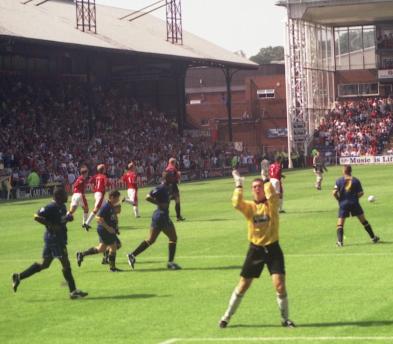
Wimbledon
FC "at home" at Selhurst Park against Manchester United
- August 1996
This was supposed
to be a temporary arrangement while Wimbledon sought a new stadium
site in south-west London. But with no tangible success, the club’s
Chairman, Sam Hammam proposed new locations for the team outside
London, including Dublin.
In 1997 Hammam
sold Wimbledon FC to two Norwegian businessmen, Kjell Inge Røkke
and Bjørn Rune Gjelsten and the following year the Plough Lane
site was sold for a supermarket redevelopment.
Meanwhile
in Buckinghamshire, the Milton Keynes Development Corporation had
for a number of years planned a stadium in the town which would
host top-flight football. They were keen on the idea of an established
League team relocating there.
In 2000 a
consortium led by Pete Winkelman proposed a large retail
development in Milton Keynes including a Football league-standard
stadium. Luton, Wimbledon, Barnet, Crystal Palace and Queens Park
Rangers were all approached to consider a move to Milton Keynes.
At Wimbledon,
Charles Koppel was appointed chairman and in 2001 announced that
the team intended to relocate to Milton Keynes. Koppel said the
club would otherwise go out of business.
Such a proposal
was unprecedented in English football and the Football League
refused permission for the move. Koppel launched an appeal,
leading to an FA arbitration hearing and the subsequent
appointment of a three-man independent commission. In May 2002
this commission ruled in favour, two to one, for the move.
The
League and FA contributions were summarised in the commission’s
report as concerns that a relocated club would, in effect,
"drive a coach and horses through the pyramid
structure", "herald, or risk heralding, a franchise
system for football whereby the investors in football could
relocate clubs at will" and "dramatically change the
defining characteristics of the English domestic game where clubs
are identified with the locality or community built up over
time"
For
its part, Wimbledon's case for the move was based on the club's precarious
financial situation and a claim that its case was unique. It
stressed that Wimbledon had lacked its own home stadium for 11
years. Milton Keynes was Wimbledon's "last chance of
financial survival".
In
their submission, they claimed that Wimbledon's
identity—"traditions, history, colours, name, strip,
stadium design and the like"—would be preserved in Milton
Keynes and supporters from London would be offered subsidised
travel and tickets.
After
the decision was made – which was final and binding, the
FA stated that it still strongly opposed the relocation. It
emphasised that its recommendation to the commissioners had been
against the move. The chief executive of the FA, Adam Crozier,
said that he believed the commission to have made an
"appalling decision".
A
spokesman for Milton Keynes Council said the people of Milton
Keynes were looking forward to the team's arrival, stating:
"It will be of great benefit to the city. Milton Keynes is
becoming a city of sport."
Looking
at all the above, firstly Milton Keynes is not a city and the
promise of keeping Wimbledon’s identity and offering fans
subsidised travel – well that never happened.
Milton
Keynes at that time had it’s own football team, Milton Keynes
City, a non league team which, with the right support and
injection of capital, could have risen through the football
pyramid to achieve league status. However, Pete Winkleman’s consortium
preferred to buy a league place rather than develop a home grown
team.
Milton
Keynes City FC was subsequently wound up.
As
the FA said at the time, if a club breaks links with its community
and moves to a new community with a new identity and yet won’t
relinquish its place in the pyramid such a move would have a
fundamental impact on the way football is organised.
So in May 2002
what could fans of Wimbledon FC do?
The
birth of AFC Wimbledon
The three man
commission in its report said that "resurrecting the club
from its ashes as, say, 'Wimbledon Town'" would be "not
in the wider interests of football.”
So were the fans
going to trek up the M1 to Milton Keynes?
No way!
Following the
FA's announcement of their decision, a group of Wimbledon
supporters led by Kris Stewart and fellow founding members Marc
Jones and Trevor Williams met in The Fox and Grapes pub on
Wimbledon Common to plan what was to be done next as part of the
protest.
It was agreed
that, as there was no right of appeal, the only option was to
start the club again from scratch. On 30 May 2002 the idea was put
forward in a Wimbledon Independent Supporters' Association meeting
to create a new community-based club named AFC Wimbledon
and an appeal for funds was launched.
On 13 June 2002,
a new manager, a playing strip and badge, based on that of the
original Wimbledon FC, and a stadium were unveiled to fans and the
media at the packed-out Wimbledon Community Centre.
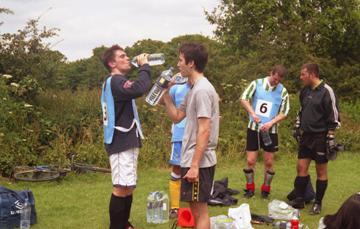
Player trials on Wimbledon Common
In order to
assemble a competitive team at very short notice, AFC Wimbledon
held trials on Wimbledon Common on 29 June 2002. This was open to
any unattached player who felt he was good enough to try out for
the team. The event attracted 230 hopeful players, from whom the club's
squad for their inaugural season was eventually chosen.
In the 2002–03
season, AFC Wimbledon competed in the Combined Counties League
Premier Division (CCL) under the management of former Wimbledon FC
player Terry Eames.
Their first ever
game, a pre-season friendly against Sutton United on 10 July 2002,
resulted in a 4–0 loss in front of a crowd of 4,657
Their first
competitive match in the CCL was away to Sandhurst Town where
around 1,500 supporters cheered their team to a 2-1 victory.
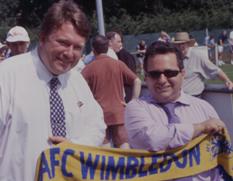
Kris
Stewart and Ivor Hellor at Sandhurst. |
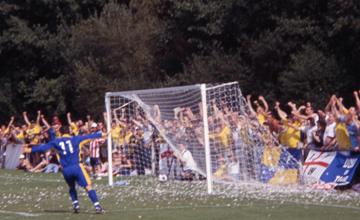
Kevin
Cooper scored AFC Wimbledon's second goal against Sandhurst
Town. |
I’m proud to
say I was there – standing on hay bales to get a good view. This
venue was very different from Selhurst Park or even Plough Lane,
but to me demonstrated the delights of non league football.
The
demise of Wimbledon FC and the creation of MK Dons
Meanwhile,
Wimbledon FC started the 2002/03 season at Selhurst Park, due to a lack of
a suitable ground in Milton Keynes that met the Football League
requirements.
The
attendance at Selhurst Park on their first game of the season was officially announced as 2,476,
including 1,808 supporters from Gillingham. As the season
progressed, AFC Wimbledon claimed an average
crowd of over 3,700, whilst Wimbledon FC attracted less than 3,000, most of whom were followers of visiting
teams.
Wimbledon FC's
relocation was delayed for over a year and in June 2003 the club
went into administration.
Pete Winkelman
had not intended to own Wimbledon FC
himself. His plan had been
to work alongside it while the new stadium was built, and then
give the ground to the club in exchange for shares and a place on
the board. He had not expected it to go into administration. With
the move threatened and the club facing liquidation, he made the
decision to take it on himself.
He secured funds
from his consortium for the administrators to pay the players'
wages, keep the club operating, and pay for the necessary work for the National Hockey Stadium to host League
football. He made clear that his group's interest was conditional
on the club moving to Milton Keynes.
Wimbledon FC
played their first match in Milton Keynes at the National Hockey
Stadium in September 2003.
Winkelman's Inter
MK Group bought the relocated club in 2004 and
changed its name, badge and colours. The team's new ground,
Stadium MK, opened three years later.
Meanwhile,
Milton Keynes City FC went out of business before the start of
the 2002/03 season following an unsuccessful drive for new directors and
investors.
The
ups and downs of the two clubs
So
how have the two teams faired?
AFC
Wimbledon had 6 promotions since 2002. 5 of these were over a 9
year period which saw them climb from the Combined Counties
League and get into the Football League.
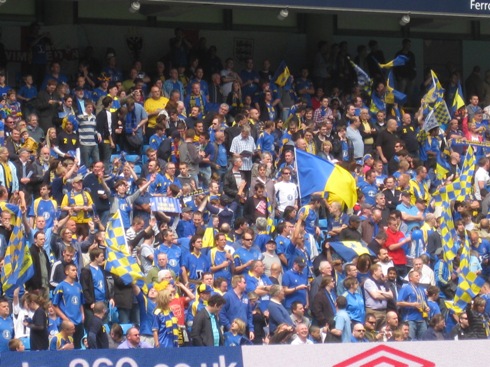
AFC Wimbledon
fans at the playoff final that saw the team promoted to the
Football League in 2011.
They played in
League 2 before their final promotion to League 1 after the
2015/16 season.
In contrast, MK
Dons had 3 promotions and 3 relegations. They started off in
League 1 but at the start of the 2018/19 season ended up on League
2. (Update: After a season in League 2 they secured
promotion back to League 1 so since the move of the club to Milton
Keynes they are in the same league as they started off in.)
Back to the end
of the 2017/18 season and in January 2018, the MK Dons chairman Pete Winkelman says it has been
"an absolutely horrible year" for the club but insists
he still has work to do before seeking investment.
Winkelman
has led the Dons since they were founded in 2004 and says the club
has lost him £3m in the past year.
He
told the BBC in an interview that: "To be going backwards,
it's terrible and it wasn't supposed to happen. I'll be honest, I
am worried - this is absolutely not where we wanted to be, it's
not where we can be."
MK
Dons chairman Pete Winkelman speaking in April 2018 says the
prospect of being relegated from League One is "absolutely
horrendous".
He
told BBC Three Counties Radio that he wanted "to apologise to
our supporters and the city of Milton Keynes - this is not what we
expect.
"I
thought going down from the Championship was bad. To be in this
position is just unthinkable. None of us planned or expected. It
is probably the worst ever thing that has happened."
Plough Lane
Meanwhile what of
the spiritual home of Wimbledon - Plough Lane?
The old stadium
was demolished and is now the site for a housing complex.
The
site of the old Plough Lane ground.
In December 2017,
AFC Wimbledon was granted permission to begin work on constructing
a new 11,000-seater stadium (which could be expanded to hold up to
20,000 in the future) on the site of Wimbledon Greyhound Stadium.
The new ground will be only 250 yards away from the original
Plough Lane, Wimbledon's home from 1912 until 1991.
Update (2
November
2020)
On the 18th
anniversary of the FA's independent commission sanctioning
Wimbledon FC's move to Milton Keynes, AFC Wimbledon signed the
final construction contract that clears the way for their return
to Plough Lane. The final game was played at Kingsmeadow without
any fanfare and earlier than planned due to Covid 19.
AFC Wimbledon
started the 2020/21 season at another temporary home - Loftus Road
whilst the new Plough Lane stadium was completed.
But on Tuesday 3 November
2020 - AFC Wimbledon played their first game at
Plough Lane. Because of Covid 19 restrictions, it will be behind
closed doors and we could only share the moment watching a video
stream. It will be one hell of a day when AFC Wimbledon fans can
actually come and see their team play at Plough Lane for real.
But what a
journey - from August 2002 when fans stood on hay bales at
Sandhurst Town to playing in their own stadium in Plough Lane.
AFC
Wimbledon - Going Home
AFC
Wimbledon announcement
Saying
Goodbye to Kingsmeadow
The
moral of the story
After the
decision by the commission to allow Wimbledon FC to relocate, the
Football Association changed their rules to ensure such a
situation does not happen in the future.
MK Dons could
have supported MK City (which was subsequently closed), but
instead bought a club and a league place.
Did MK Dons earn their
place in the Football League?
Many would argue
not - unlike AFC
Wimbledon who earned their place in the League 1 after starting in
level 9 of the football pyramid.
Not bad for a
club whose creation was, to quote the three man commission, "not
in the wider interests of football".
And that is why
in July 2018 AFC Wimbledon fans have a smile on their faces - and
why in November 2020, despite the Covid-19 lockdown, we have an even
bigger smile!
|

